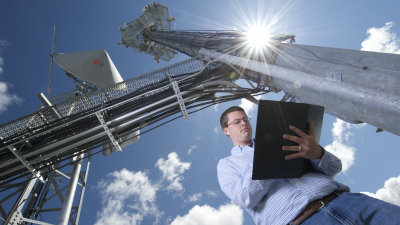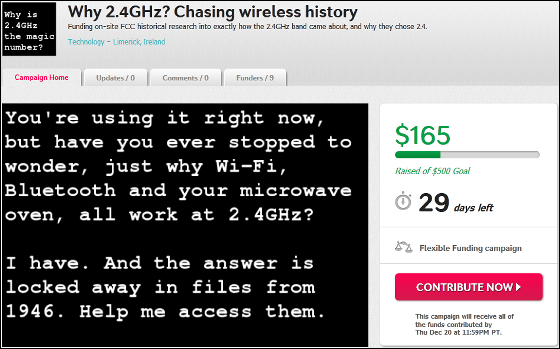"Why is the frequency band used for wireless communication 2.4 GHz?" The last huge wall that was found before the student under investigation

ByIdaho National Laboratory
Frequency of "2.4 GHz band" is used for wireless communication such as Wi-Fi and Bluetooth casually using. So why is "2.4 GHz (2400 MHz)"? One student who chose "wireless communication" as the theme of the doctoral dissertation keeps chasing this mystery and finally the goal has come to be visible, but a tremendous wall has come to a stand in front of him. We are seeking help with cloud funding to cover the investigation cost.
Why 2.4 GHz? Chasing wireless history | Indiegogo
https://www.indiegogo.com/projects/why-2-4ghz-chasing-wireless-history/

University of Limerick, Hugh O'Brien chose the theme of the doctoral dissertation "Interference between wireless communications". O'Brien who began writing "at the introduction part" because it is the same frequency band that interferes "was to have the question" Why is it the same frequency band? " Mr. O'Brien, who had time as a student and had knowledge as an engineer, had unlimited desires to know why this was.
If you hit this question, most technicians answer "Because there is a microwave oven". However, O'Brien says that this is an "answer" rather than a "triangle". In the first place, the one who was decided that the frequency used for wireless communication is "2.4 GHz (2400 MHz)" is first, and the microwave oven operates arbitrarily in a wide range from 1 GHz (1000 MHz) to 20 GHz (20000 MHz) It is because it is possible. However, as Mr. O'Brien proceeded the investigation, it turned out that the original microwave patents were taken at frequencies around "3 GHz (3000 MHz)". Why is this now defined in the same 2.4 GHz band as wireless communication?
O'Brien read the material of the ITU (International Telecommunication Union) in the 1940's and FCC (Federal Communication Commission) etc. As a result, 2300 MHz to 2500 MHz was allocated to air traffic control on FCC annual report 396 page of 1945 After that, it was found that 2300 MHz to 2450 MHz was reassigned for amateur radio, and 2450 MHz to 2700 MHz for mobile (wireless communication) in the June 27, 1946 version of the frequency distribution table .
And at the ITU Atlantic District Conference in 1947, the United States made 50 mc before and after 2450 mc (megacycles)ISMRequest for use. Megacycle isInternational unit systemBecause it was not adopted in now it is now shown in Hertz, this means that the United States has requested to assign 2400 MHz to 2500 MHz to the ISM band.
In the minutes of this conference, "The American delegate assigned this band to the ISM band already had domestic high-frequency therapy equipment and electronic cooking utensils, and this cooking utensil is installed in vessels and aircraft of the Atlantic routes It may be written "It is written. O'Brien thought that the American delegate referred to the first commercial microwave oven Raytheon RaderRange at this conference and it was this FCC that FCC made the frequency to 2450 MHz instead of 3000 MHz, It is anticipated that it might have been related to the operating parameters.
In the FCC annual report of 1947, it is written in the ISM section that "a hearing of these regulatory proposals opened by participation of medical and industrial relations stakeholders was held in December 1946" In the report of 1946 there is no description about ISM, O'Brien is confronted that the frequency of the radar range was decided at this hearing in 1946.
However, since these detailed materials are in a state where they can not be browsed online, Mr. O'Brien informs the data management contractor that they want me to show the materials related to the above items. Then, I got the following response.
** It is a company.
We will get 50 dollars (about 4100 yen) per hour of search time for material requests that are not urgent.
Also, it costs 10 dollars (about 820 yen) per file to send the file by mail attachment, and the file costs 30 cents per page (about 25 yen) per page.
Honestly speaking, I am not in a position to grasp where to search for the requested file from, or whether it exists in the first place.
Probably it will take several hours to notify us as useful information.
O'Brien did not get rich enough to make money for this material, but thinks that "There should be technology fans around the world who care about this result" and use cloud funding I came up with ideas.
The target amount is set at 500 dollars. This is only 10 hours when converted to the search time of the data management contractor. However, while O'Brien spent two to three times already to obtain this information, this company should have an archive at hand. "We can store and exclusively access all FCC files and documents" is the wording of the site of this company, but if this is true, you can get answers by paying and investigating money That is why.
Cloud Funding deadline is December 20. On November 22th at 17 o'clock, the remaining $ 335 (about 28,000 yen).
2012/11/22 18: 36:
More than 50% of the investment gathered, and the remaining 215 dollars (about 18,000 yen) came.
2012/11/26 9:39
"Although it is such a small quest, I did not anticipate that the funds will reach the planned amount as soon as possible", money gathered at a speed higher than expected by O'Brien and raised a safe schedule of $ 500. Currently it reaches 815 dollars (about 67,000 yen).
Does anyone know of someone who worked at Raytheon, along with thanks words from O'Brien? The call is being made. Perhaps it's a microwave ovenMagnetronOle O'Brien said that he felt that the band had been suppressed by making an effort to prevent other FCCs from being taken away as the operation stabilized at 2450 MHz in making the same. Regarding the circumstances, it seems that Raytheon will be asked directly, but unfortunately Raytheon seems not to help scientific research as a company.
Related Posts:
in Science, Posted by logc_nt







